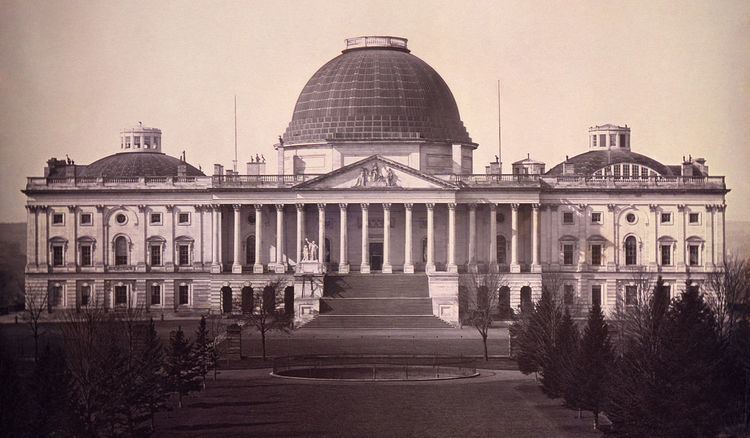The Thirty-third United States Congress was a meeting of the legislative branch of the United States federal government, consisting of the United States Senate and the United States House of Representatives. It met in Washington, D.C. from March 4, 1853 to March 4, 1855, during the first two years of the administration of U.S. President Franklin Pierce. During this session, the Kansas-Nebraska Act was passed, an act that soon led to the creation of the Republican Party. The apportionment of seats in the House of Representatives was based on the Seventh Census of the United States in 1850. Both chambers had a Democratic majority.
March 4, 1853: Franklin Pierce became President of the United States
April 18, 1853: Vice President William R. King died
July 8, 1853: Commodore Matthew C. Perry arrived in Edo Bay with a request for a trade treaty
December 30, 1853: Gadsden Purchase: The United States bought land from Mexico to facilitate railroad building in the Southwest
March 20, 1854: Republican Party founded
May 30, 1854: Kansas-Nebraska Act, ch. 59, 10 Stat. 277
March 3, 1855: The U.S. Congress appropriates $30,000 to create the U.S. Camel Corps
March 31, 1853: Convention of Kanagawa signed with the Japanese government, opening the ports of Shimoda and Hakodate to American trade
January 26, 1854: Point No Point Treaty signed
May 30, 1854 – Kansas Territory was organized.
May 30, 1854 – Nebraska Territory was organized.
For the beginning of this congress, the size of the House was increased from 233 seats to 234 seats, following the 1850 United States Census (See 9 Stat. 433).
President: William R. King (D), until April 18, 1853; vacant thereafter.
President pro tempore: David R. Atchison (D), until December 4, 1854
Lewis Cass (D), December 4, 1854
Jesse D. Bright (D), from December 5, 1854
Speaker: Linn Boyd (D)
Democratic Caucus Chairman: Edson B. Olds
This list is arranged by chamber, then by state. Senators are listed in order of seniority, and Representatives are listed by district.
Senators were elected by the state legislatures every two years, with one-third beginning new six-year terms with each Congress. Preceding the names in the list below are Senate class numbers, which indicate the cycle of their election. In this Congress, Class 1 meant their term began in the last Congress, requiring reelection in 1856; Class 2 meant their term began with this Congress, requiring reelection in 1858; and Class 3 meant their term ended with this Congress, requiring reelection in 1854. The United States consisted of 31 states during this Congress.
Skip to House of Representatives, below
The names of members of the House of Representatives are preceded by their district numbers.
The count below reflects changes from the beginning of the first session of this Congress.
replacements: 7
Democrats (D): no net change
Whigs (W): 2 seat net loss
Free Soilers (FS): 2 seat net gain
deaths: 2
resignations: 4
interim appointments: 1
Total seats with changes: 13
replacements: 7
Democrats (D): 2 seat net loss
Whigs (W): 3 seat net gain
Free Soilers (FS): 1 seat net loss
deaths: 4
resignations: 4
Total seats with changes: 8
Lists of committees and their party leaders.
Agriculture
American Association for the Promotion of Science (Select)
Atmospheric Telegraph Between Washington and Baltimore (Select)
Audit and Control the Contingent Expenses of the Senate
Claims
Commerce
Distributing Public Revenue Among the States (Select)
District of Columbia
Finance
Foreign Relations
French Spoilations (Select)
Indian Affairs
Judiciary
Loss of Original Papers of Mark and Richard Bean (Select)
Manufactures
Mexican Claims Commission (Select)
Military Affairs
Militia
Naval Affairs
Ordnance and War Ships (Select)
Pacific Railroad (Select)
Patents and the Patent Office
Pensions
Post Office and Post Roads
Printing
Private Claims Commission (Select)
Private Land Claims
Protection of Life and Health in Passenger Ships (Select)
Public Buildings and Grounds
Public Lands
Retrenchment
Revolutionary Claims
Roads and Canals
Sickness on Emigrant Ships (Select)
Tariff Regulation (Select)
Territories
Whole
Accounts
Agriculture
Claims
Commerce
District of Columbia
Elections
Engraving
Expenditures in the Navy Department
Expenditures in the Post Office Department
Expenditures in the State Department
Expenditures in the Treasury Department
Expenditures in the War Department
Expenditures on Public Buildings
Foreign Affairs
Indian Affairs
Invalid Pensions
Manufactures
Mileage
Military Affairs
Militia
Naval Affairs
Patents
Post Office and Post Roads
Public Buildings and Grounds
Public Expenditures
Public Lands
Revisal and Unfinished Business
Revolutionary Claims
Roads and Canals
Rules (Select)
Standards of Official Conduct
Territories
Ways and Means
Whole
Amending the Constitution on Presidential and Vice Presidential Elections
Enrolled Bills
San Francisco Disaster
Architect of the Capitol: Thomas U. Walter
Librarian of Congress: John Silva Meehan
Chaplain: Clement M. Butler (Episcopalian)
Henry Slicer (Methodist), elected December 7, 1853
Secretary: Asbury Dickens of North Carolina
Sergeant at Arms: Robert Beale
Dunning R. McNair, elected March 17, 1853
Chaplain: William H. Milburn (Methodist)
Clerk: John W. Forney
Doorkeeper: Zadock W. McKnew
Postmaster: John M. Johnson
Sergeant at Arms: Adam J. Glossbrenner

